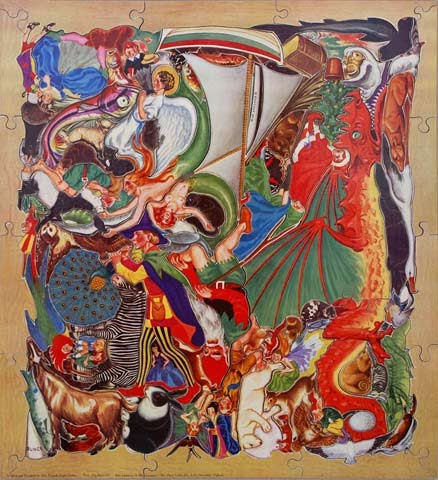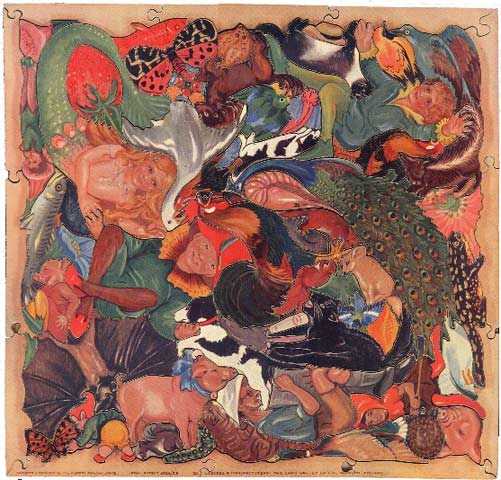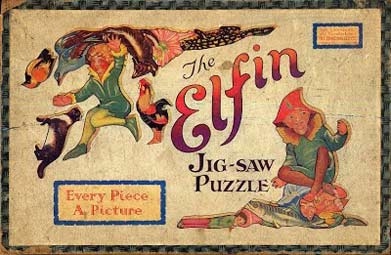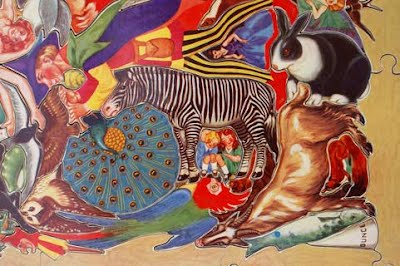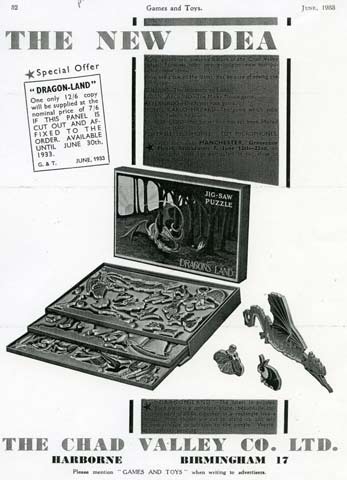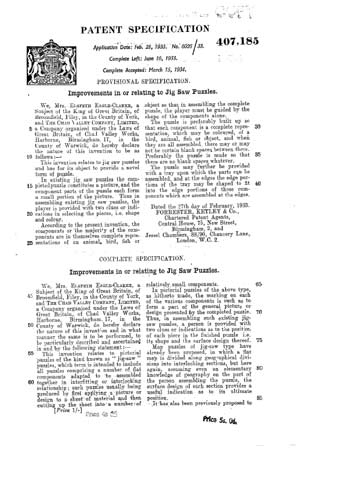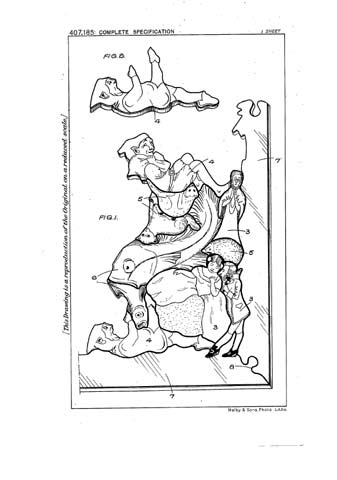Cluster Puzzles of Elspeth Eagle-Clarke (1876–1948) 1. Dragon’s Land, 1934, 15½” x 17”, 81 pieces 2. Elfin, c. 1934 of 57 pieces Elspeth Gertrude Eagle-Clarke, née Fell (13 June 1888–15 September 1969) born in Parham, Sussex, United Kingdom, can be described as one of the pioneers in cluster puzzle history (although of course not known by the title of the day), with the fifth recorded instance. There are two confirmed instances of a commercial nature, for the Chad Valley company, Dragon's Land and The Elfin, both likely of around 1933 and possibly three others, detailed below. Incidentally Dragon’s Land is spelt in the various literature on the puzzle in a variety of ways and variations, with Dragon's Land’ (box lid), ‘Dragon-Land’ (advert, Games and Toys), and ‘Dragon’s Land’ (box interior) to give a few. There appears to be no one official instance. The most obvious reference would be from Eagle-Clarke herself, but unfortunately she does not discuss this, not even, amazingly, in the patent! Given all this, I thus use the obvious instance as detailed on the box lid, hence Dragon’s Land. The Puzzles Photo Credit: David Shearer, left, ? right. Dragon's Land, left, The Elfin, right Boxes Dragon's Land, left, The Elfin, right Detail of Dragon's Land Photo Credit: David Shearer. Detail Box Literature with Dragon's Land Puzzle Photo Credit: David Shearer, Advert, left; Label, right Order and Dates of the Puzzles Dragon’s Land appears to have been the first puzzle, preceding Elfin, as detailed in Games and Toys: Dragon-land… and which will be followed by a smaller puzzle entitled “Elfin-folk”. That said, both were likely undertaken more or less at the same time, arising from the commission by Chad Valley; both are advertised in the box. The date of the two artworks is not exactly known, although with reasonable accuracy can be surmised, as of c. 1933, from the patent and Games and Toys. Both give a date of 1933, the earliest recorded in the literature. To be exact, the patent application was in February, whilst Games and Toys in June. Likely, the artwork was more or less contemporary, although of course could have been a few years earlier, but this would appear unlikely. Of note is the date in relation to the 1930s jigsaw craze, of which it would appear to have been influenced by its introduction. Advert in Game and Toys Catalogue An advert in Games and Toys, a British toy trade toy catalogue, of June 1933, p. 74 is invaluable in many ways. Of note is that it mentions other puzzles, namely Robin Hood and Cupid and the Birds, but no details of these are to be found. Photo credit: Anne Williams Photo credit: Anne Williams The Patent The patent, 407,185 gives an ‘Application Date’ of February 28 1933, ‘Complete Left’ June 16, 1933 and ‘Complete Accepted’ March 15, 1934. There are various nuances as to patents here, much of which was unaware of. The Application date is obvious, but quite what the two ‘complete’ references entail is unclear. And then there's 'Provisional Specification’ and ‘Complete Specification’. There are minor changes in text here. Whatever, it is not a point of undue concern. It is clear, with good reason, that Eagle-Clarke believes that this is the first instance of the kind, although as detailed above, this is not so. The patent is of four pages, the last of which is illustrated, of a particularly completed section and an individual piece. Of particular interest are certain passages, as discussed below. Reference is made to the difference between a standard jigsaw and this innovation, of a puzzle piece of a whole motif. Page 1, line 15: In existing jig saw puzzles the completed puzzle constitutes a picture, and the component parts of the puzzle each form a small portion of the picture… According to the present invention, the components or the majority of the components are in themselves complete representations of an animal, bird or fish or object... The tessellation principle of no gaps is made clear, albeit with an alternative option of this, of a ‘looser’ assembly. P. 1, line 30: The puzzle is preferably built up so that each component is a complete representation, which may be coloured, of a bird, fish or object, and when they are assembled there may or may not be certain blank spaces between them. Preferably the puzzle is made so that there are no blank space whatever. The silhouette quality is addressed, p. 2. Line 85: Each component [piece, or tile] has an outline which conforms as closely as possible to that of the particular object represented... In short, from this Eagle-Clarke understands all the issues of a high-quality cluster puzzle, namely of a recognisable silhouette and no gaps and by implication, overlaps. Of note here is that no mention is made of Dragon’s Land or Elfin, which is a little surprising. However, the patent is illustrated with a partial illustration from Dragon's Land. Rather, these are referred to as generic jigsaw puzzles as 'Improvements in or Relating to Jig Saw puzzles'. Note that this is not the first patent issued for the genre, as Eagle-Clarke’s is the third; Mark Dodd has a 1923 patent for a ‘Toy’ and Arnold Guyot Dana has a 1929 patent for a ‘Puzzle’. Strictly therefore, given prior instances, this should not have been awarded a patent. However, unlike Eagle-Clarke’s patent, whether these were marketed is unclear, none of these have been found as puzzles. Earlier Commercial Instances Although Eagle-Clarke commercial work was one of the earliest instances, it was not the first, but rather the second. The honour of the first mass-produced commercial instance of a cluster puzzle was by Art Nugent, of the US, with three works of the early 1930s, produced by Frederick Beach. Family Eagle-Clarke can be described as from a broadly ‘well-to-do-family’. Her family background is most interesting, including some adventurers! Her father, William Edwin Fell, was a colonel and Justice of the Peace (a lay magistrate) and had three servants for a household of seven. Francis Eagle-Clarke (1885–1960), her husband, was a prominent solicitor with his own practice in Filey, Yorkshire for many years, with a family connection of no less than 150 years. Goldie Gardner (1890–1958), son in law, was a famous racing car driver of his day and was an associate of the well-known British speed record breaker Donald Campbell. Una Eagle-Clarke (1914–2008), her daughter, their only child, went on to become Mayor of Eastbourne twice over. She too had one child, Rosalind Goldie Gardner, of whom I am indebted for much detail on Eagle-Clarke. It is not entirely clear what Elpseth's occupation was. In the 1911 census this is left vacant. Interestingly, two of her sisters are listed as ‘miniature painter’ and ‘artist’. Life and Artwork - Reminisces by John Fell and Rosalind Gardner In more recent times, Eagle-Clarke’s life and artwork have in general sunk into obscurity, save for the occasional auction sale and her art in collections at the Towner Art Gallery, Eastbourne, East Sussex. Little is now known of her in the art world, and wider, at least in official publications. There is next to no detail on her on the web. Occasionally Dragon’s Land shows up on eBay and other auction sites, but typically there is nothing on the designer herself. Essentially her life story and the two puzzles are unknown, at least to the general public. However, upon my investigations, I have indeed been able to document her life and artwork, and now her story can be told in depth. My investigations led me to a family history by John Fell, in which Eagle-Clarke is mentioned, and secondly, arising from the Fell history, and more substantially, with finding her granddaughter, Rosalind Goldie Gardner, who added much to the story. Below I show extracts taken from both, of online and email correspondence respectively. Reminisces by John Fell John Fell, a distant relative of hers, wrote the Fell family story on the web in April 2007 [*], and of which upon a broad family discussion contained much detail on Elspeth, and in particular a short but detailed piece on her personality, nature and interests, and of which refer to her cluster puzzles, but not by name: Elspeth was very strong-minded and multi-talented; a reasonably accomplished violinist and an excellent amateur watercolour artist. Her style was romantic rather than flamboyant. But Elspeth's real power lay in her talent for thinking in three dimensions. She always had what she called her studio, with fret saw and other woodworking tools, where she would create jigsaw puzzles and working toys out of odd bits of wood, without benefit of working drawings. The ideas seemed to flow straight from her mind into the finished object. She was good enough at her craft to obtain commissions from Chad Valley for toys, and from various publishers for book illustration. My brother still has one of her jigsaws. It is a wonderful creation in which every interlocking piece is a complete real or fanciful creature - a flower, fish, gnome or fairy. She was a great strength in the family. In childhood, she and Rudston* were unusually close, and this bond persisted right through their lives. Rudston loved this sister above all others. Elspeth married Francis Eagle-Clarke, a Filey solicitor, and lived with him at Willerby Lodge, a hunting lodge near Staxton. They had one daughter, Una, who married MG's pre-war racing driver Goldie Gardner. Una and Goldie lived in Eastbourne and had a daughter, Rosalind. After Goldie's death, Una became Mayor of Eastbourne for a time. Elspeth died in Eastbourne, again without benefit of medical attention as she had followed her father into Christian Science, but times had changed and there was no problem in obtaining a death certificate without autopsy for someone so obviously deceased from terminal cancer. * Rudston refers to Louis Frederick Rudston Fell, John Fell’s father. Such an account is invaluable in many ways, personal and puzzle wise. Reminisces by Rosalind Gardner On 5 January and March 2018 I asked Rosalind a series of questions by email. Her (edited) replies: 5 January RG. I was very close to my Grandmother and spent a lot of time with her in her studio. I have a number of her sketchbooks somewhere in storage and many photos of her. Just before I go I saw two of my Grandmother's puzzles in glass cabinets in Blenheim Palace in the 70’s or 80’s. 1 March DB. In particular, I am intrigued by her sketchbooks – do these contain concept sketches for her cluster puzzles? And indeed, anything pertaining to this in a generalised sense. RG. I haven't looked through her sketchbooks for some years. I remember them full of watercolours. Some of them [are] obviously ideas for some of her larger paintings. I still have some of those. Though like the sketchbooks they are stored away. She painted a lot of magical fairy pictures especially for when Mum was born in 1914 and me in 1947. She would exhibit in the Eastbourne Gallery a lot apparently. I don’t remember any designs for her cluster puzzles. DB. Is there anything about her interaction with Chad Valley? RG. I cannot remember seeing anything about Chad Valley. DB. I note in your photo some kind of puzzle. Is the game of ‘Tiles’ of her own devising? Was she a puzzle enthusiast in the broad sense? RG. Yes my Grandmother made the puzzle herself and the notebook is full of the designs one could do for various points. She used a fret saw and made animals. I have a horse she made of wood. Two of her sisters were also artistic but not so gifted. On reflection she was very diligent in her studio. She made a witches house and the witch and assembled a farm with animals for Mum and passed [it] on to me. RG. My Dragon’s Land puzzle is in practically mint condition! I feel it might be a prototype as it doesn't have all the labelling I have seen on the other boxes on the web. I was only allowed to play with it if I was very careful. I don’t think I ever had Elfin. Mum shared her stuff around the close cousins. I don’t know if she was a puzzle enthusiast. My Grandpa was a solicitor and his hobby was carpentry and his workshop was adjoining the kitchen! Her studio was at the top of the house in a room bathed in light. Non Cluster Puzzle Artwork, Book Illustration Further researches show that she was an artist of the day (coming from an artistic family, with at least two of her other five sisters listing their occupations as artists), favouring watercolours, and of which at least three of her paintings, of fairies and fantasies, have survived, and auctioned (2007), with the price fetched of respectable amounts, of £100, £520, £580. She also illustrated the book Miscellaneous Musings by David T. Smith of 1936 (but not the earlier 1929 edition, as I latterly found to my cost!). Even here, there is very little detail given. Save for the credit, no other mention is made of Eagle-Clarke. There are 14 illustrations, in black and white, on pp. 5, 9, 16, 27, 45, 46, 52, 65, 73, 79, 85, 111, 117 and 119. The artwork is a mixture of straightforward scenes from life and occasional fantasy aspects. The circumstances of the collaboration are not known. Did Elspeth know Smith, or vice versa? Was it initiated by the publisher? Also of note is that, Fell, above, moots of other books being illustrated, but without detail. Three More Puzzles? The two known puzzles are historically significant in three ways: the fifth such instance, the third patent granted and the second commercial instance. As alluded to above, note that the puzzles are qualified by the possibility of three more instances, from two different sources: As related by Tom Tyler to ‘Dajavous’ (Jackie Armstrong) at a Benevolent Confraternity Dissectologists (BCD) 2015 meeting (See notes). 1. Tom Tyler said that two others were produced - Peter Pan and Robin Hood, but he has never seen either, supposing that the novelty of the concept had worn off by the time they were issued. 2. Games and Toys catalogue, June 1933, p, 52: Dragon-land… and which will be followed by a smaller puzzle entitled “Elfin-folk” and then “Peter Pan” and “Cupid and the Birds”. Very interesting! Of course, having been alerted to mooted further examples by Armstrong, I then emailed Tyler for further details, but he did not respond. Tyler is a jigsaw authority, and so the account is trustworthy, but how he became aware of this detail is not clear. It seems unlikely that this was from Games and Toys, as although Peter Pan is common to both accounts, Robin Hood is not, whilst no mention is made of Cupid and the Birds. The matter remains unresolved as of this writing. The background is that Armstrong too has an interest in Eagle-Clarke, and has written about her on her Flickr page. Transcripts of the Boxes As to the puzzles themselves, more by a good chance than anything else, there is indeed considerable detail from the boxes. For convenience, I show the box text below: “Dragon's Land” Jig-Saw Puzzle Patents Pending This “every piece a picture” kind of puzzle now makes its appearance, and although it may seem unbelievable at first glance, when the approximately 100 pieces are all correctly assembled inside the outer framework, a complete rectangle is obtained. On the underside of one of the trays there is a photograph of the puzzle assembled, which no one should look at as a last resource, because many hours of enjoyment will be obtained in trying to fit together these beautifully shaped pieces. Many of them too, stand up, and may be used as toys by the younger members of the family. Once upon a time there was a very fierce dragon who lived in a wood (you will see him on the box top). He thought that that the little elves would make an excellent meal; of course the elves did not think so, and they ran off as fast as their legs would carry them, but the Dragon ran faster and one of them had to run up a tree to escape (and elves can run up trees very quickly), so the Dragon chased the other one and was just going to eat him up when a fairy flew out of the wood and magic’d him away to the land where the fairy lived. All sorts of strange people were there, the Pied Piper, Mermaids and lots of birds and butterflies, boats to sail on, books to read, Christmas trees to play with, squirrels who were very fond of nuts, little boys and girls, a dunce’s cap for those who forget their lessons, and like all fairy stores, the elves lived happily ever after. The “every piece a picture” Jig-Saw puzzles are made only at The Chad Valley Works, Harborne, England. And Like some rare specimen is to the collector so is this puzzle to the jig-saw enthusiast - a puzzle of such unusual character that we, with our years of experience have seen nothing to equal it. And how shall it be described? Imagine Puck summoning all the Elfin creatures, the birds, the beasts and even Man, and arranging them in one glorious symphony of colour for the dedication of his queen, Titania. This fantasy reproduced in glowing hues by a gifted artist, has been cunningly cut from wood by skilled workers. Every elf, swan, mermaid and fish, is a picture in itself, colourful and complete, yet each dovetailing together into the brilliant design we illustrate. "Every piece a picture" (Supplied to Her Majesty the Queen) No. 3036 DRAGONSLAND 10/6 No. 3035 ELFIN 7/6 Patent No. 407185 The text is most illuminating. The cluster puzzle nature is also made clear, with: ...every piece a picture… and Every, elf, swan, mermaid and fish, is a picture in itself,… Further, one can see that there was a dual play purpose, as many of them stand up and may be used as toys by the younger members of the family, in line with many other succeeding puzzles Both puzzles are today extremely rare; indeed, I know of only three extant instances of Dragon’s Land [*] and just one of Elfin. Dragon’s Land is currently available (on eBay) for the princely sum of $475 or £383. General Observations on Dragon’s Land and Elfin Both puzzles are of a similar nature and style, and of which in broad terms I discuss as an entity. Pleasingly, these are the strictest tessellation definition, of no gaps and overlaps, and so, unlike others can be considered as superior.The titles appear to be derived from the main characters of the puzzle, these featuring prominently in size. Both puzzles are of a broad square format, with no orientation concerns of motifs. A feature of these is that the rendering is a more true-to-life image, of a near photographic quality, with much finer detail than most others. They have an impressively high number of motifs, 81 for Dragon’s Land and 57 for Elfin. This is much higher than with most others and furthermore are of a superior instance, of whole bodies, and of good articulations and of a true tessellation, of a no gaps (or overlaps) premise, albeit of the odd exception. The premise of the content appears to be of a ‘fantasy nature’, as apparently described by Eagle-Clarke herself (above), of mostly animals and the occasional inanimate object. Note that the puzzles were expensive of the day, of 10/6 and 7/6, as they were painstakingly cut by hand with a fret saw (likely reflecting the different amounts of work required for cutting). As a rough comparison, in 1930 the average weekly wage for a timework labourer in the engineering field was £1 11s (shillings) 8d (pence) for a week of just over 50 hours, or just under a shilling per hour. This thus equates to, for the more expensive puzzle, of two and a half days work today to pay for this! Elspeth Eagle-Clarke Motif Inventory - Numerating the Individual Animals Although at first glance the task of compiling an inventory may be thought ‘simple’, with the task of describing one piece, one motif, in actuality this is not so, for a variety of reasons. Without the puzzle to hand, of necessity, the count and description relies on photos of the whole puzzle. From this it is not always easy to make distinctions of the individual pieces. A few pieces are inside another. Further, due to the photorealist nature of the portrayal, it is not always straightforward to determine the number of pieces or motifs on occasion. Undoubtedly, to be sure, a dismantled puzzle would need to be inspected. At times, the descriptions and groupings are somewhat subjective. For instance, under human figures, does this include fantasies such as Elfins[*], elves, pixies? Should there be two distinctions? And others too, specific birds, or generic? Further there are problems with others that lack enough clarity to be definitive as to motif. This is simply listed as unidentified. All this being so, the listing below is subject to revision. Thorough as is possible yes, but not definitive. As an aside, compiling this listing also has the bonus of a more intense scrutiny; although previously I have examined, there was much here that I was unaware of. At times, I have been generous in attributing. However, as a rough and ready listing, this includes, with frequency in brackets: Inventory Dragon’s Land: Human Figure (17) Birds (11) Fish (6) Cat, Fox, Mermaids, Otter, Rodent (2) Angel, Armadillo, Bear, Boar, Boat, Book, Butterfly, Christmas Tree, Crocodile, Dog, Duck, Dunce’s Cap, Frog, Goat, Hamster, Hedgehog, Lamb, Lizard, Rabbit, Shark, Shrew, Swan, Tapir, Quadruped, Mink, Zebra (1) Two motifs are unidentified. Elfin Birds (9) Human Figures (8) Cat, Dog (3) Butterfly, Fish, Flower, Pig, Squirrel (2) Bat, Caterpillar, Hat, Hen, Horse, Lizard, Mallard, Mermaid, Mouse, Prawn, Rooster, Strawberry, Weasel (1) Seven motifs are unidentified. Assessment So what to make of all this? For both puzzles, human figures and birds are favoured, with other motifs typically of one or two instances. As to each puzzle: Dragon’s Land: Human figures (17), birds (1) and fish (6) are favoured, with 34 instances, all other motifs are either of one or two instances. A variety of animals of different scales and orientations are included, some instantly recognisable, some partially, and others not, best described as of an imaginary nature. These are overwhelmingly of animals, with the occasional inanimate objects included. Within a broad animal description, the puzzle is themed. As I discuss elsewhere, this type is to be favoured on account of its cohesiveness. Listing a definitive inventory here, although appearing a simple task at first glance, with * and * distinct pieces, is next to impossible, with at times numerous nomenclature and interpretation possibilities as to any one creature. Further, the Elfin puzzle in particular is difficult, with only one picture. Other Artworks Of general interest is examining her other artworks and seeing if there is any correlation between these and her cluster puzzle work. As can be seen, there is indeed, with a decided fairy theme. Mother and baby with attendant fairies (sold, in 2007, for £100) The Fairy Fountain by Moonlight Sketch of Fairies Woodland Fairies, 1923 (sold for £580) Flower Study? Children by a Stream There is also her work in Smith’s book. Open Questions: 1. What has happened to the original artwork, and by extension, the concept sketches? Is it still in the Chad Valley archives? Chad Valley per se no longer exists, and for a considerable while too. The company was one of the UK's leading toymakers for most of the 20th century, and by 1960 it was operating seven factories and employing over 1,000 people. In the 1970s however, it closed several factories and cuts were made in staffing and production. 1975 saw only two factories remaining. The company was taken over by Palitoy in 1978 and subsequent takeovers thereof. Subsequently, Palitoy donated their archives to the Victoria and Museum, London. However, upon an online database search, nothing was found relating to Eagle-Clarke. With so much upheaval, finding this may be near to impossible! 2. How many units of each puzzle were produced? It would appear that this was mass-marketed, but very little seems to have survived. I know of no more than five extant instances. 3. Are there indeed three other instances, of Peter Pan, Cupid and the Birds and Robin Hood? Come on, Tom Tyler, let me know on your two mooted instances! Two mails to him went unanswered. 4. What of Elspeth Eagle-Clarke herself? Although I now have much detail from Rosalind, I would still dearly like to know more biographical details of her, as well of her artworks, and not just necessarily of cluster puzzles. 5. John Fell mooted other books illustrated by Elspeth, but does not go into any detail. Does anyone know of these? I know only of the one, Miscellaneous Musings, by David T. Smith, as detailed above. 7. Does anyone know of John Fell at all? He may have more detail on Elspeth to relate, and must be one of the few still living who knew her. Upon research, from information kindly supplied by Richard Carr, an associate of John Fell, I have found that his last known address was Marshchapel, Grimsby, which is only 11 miles away from me! I am told that he would be about 82 now (2017), and was still alive two or three years ago. Of course, I wrote to him, but unfortunately met with no response. Whether he is still with us, has moved away, or is now no longer interested in family matters remains to be seen. I looked in the phone book for him without joy. Again, he may be ex-directory. 8. Or indeed, does anyone have any other Eagle-Clarke detail that may be of interest? No detail is too small to mention. Timeline 1888. Elspeth Gertrude Fell born 13 June, Parham, Sussex. Elspeth was the fourth of seven children of William Edwin Fell and Alice-Pickersgill-Cunliffe. 1910. Engagement to Francis Eagle-Clarke, aged 22. Location: East Riding of Yorkshire. 1912. Marries Francis Eagle-Clarke, solicitor, on 19 July. 1914. Una Eagle-Clarke, Elspeth’s first and only child born. 1923. Earliest known artwork, ‘Woodland Fairies’, a watercolour. 1928. Reference of painted scenery artwork in The Hull Daily Mail. 1933. Patent 407,185 for ‘Improvements in or relating to Jig Saw Puzzles’ (Dragon’s Land). The patent also gives her residence, Broomfied, Filey in The County of York. When she moved from Sussex is not clear. 1934. Dragon’s Land and Elfin Puzzles by Chad Valley. 1936. Illustrates, with line drawings, the book Miscellaneous Musings, on ‘countryside matters’ for David T. Smith. 1947. Rosalind Goldie Gardner, only child born. 1949. I believe that this was the year the family moved to Eastbourne, Sussex after the retirement of Francis Eagle-Clarke as a solicitor. 1957. First mention (in a probate notice) of Elspeth at Eastbourne in Herald Chronicle. 1960. Husband dies 13 October, Eastbourne, Sussex, age 75. 1969. Dies 15 September, Eastbourne, Sussex, age 81. 1982. Retrospective exhibition of paintings in the Towner Art Gallery, Eastbourne. Notes [*] The ‘Benevolent Confraternity of Dissectologists’ (BCD) is the name of a collective of jigsaw puzzle enthusiasts in the UK, formed by Tom Tyler. [*]. In the collections of David Shearer and Rosalind Gardner. [*] And what is an ‘Elfin’? I think I was unfamiliar with the term! Dictionary.com gives for Elfin: (of a person or their face) small and delicate, typically with a mischievous charm. "her black hair suited her elfin face" relating to elves. "an enchanted world of fairies in elfin glades" late 16th century: from elf, probably suggested by Middle English elvene ‘of elves’, and by Elphin, the name of a character in Arthurian romance. Elfin adjective of or like an elf. small and charmingly spritely, merry, or mischievous. [*] Hannas, Linda (Introduction). Two Hundred Years of Jigsaw Puzzles. Dragon’s Land entry for Mrs Elspeth Eagle-Clarke, p. 37, albeit without a picture. Disarmingly, two mistakes are made in the text, albeit minor, with ‘Miss’ rather than Mrs and ‘Clark’ rather than Clarke. 66. Dragon’s Land 1934 Manufactured by Chad Valley Co Ltd. 17 x 15½ in. Colour print of design by Miss [sic] Elspeth Eagle-Clark [sic]. Each piece is a picture in itself dovetailing into a complete design London Museum 67.92/2. An original picture of 1930 mounted on plywood in 1967 by the same craftsman at the Chad Valley Works who cut the prototype in 1934. Apparently, the puzzle was recut for the exhibit; see the Birmingham Daily Post. Saturday June 8, 1968 which puts this statement otherwise obscure comment into context.
[*] Miscellaneous Musings Note that the Eagle-Clarke illustrations/references are not in the 1929 first edition. In relative terms a disappointment, at least for research purposes; save for the credit, no other mention is made of her. Of course, this at least shows more of her artwork, and so is invaluable in this regard. There are 14 illustrations, in black and white, pp. 5, 9, 16, 27, 45, 46, 52, 65, 73, 79, 85, 111, 117 and 119. The artwork is nothing special per se, a mixture of straightforward scenes from life and occasional fantasy aspects. The circumstances of this collaboration are not given, or known from elsewhere. Towner Art Gallery (Wikipedia) Towner Art Gallery is located in Eastbourne, East Sussex, on the south coast of England. It hosts one of the most significant public art collections in the South of England and draws over 100,000 visitors a year. It was described by ITV News as ‘the region's biggest art gallery’, in 2017. It boasts in excess of 5,000 works of art by historic, modern and contemporary artists. Patents: https://en.wikipedia.org/wiki/Glossary_of_patent_law_terms#C Application Patent Application An application for a patent, or patent application, is a request by a person or company to the competent authority (usually a patent office) to grant him a patent. By extension, a patent application also refers to the content of the document which that person or company filed to initiate the application process. This document usually contains a description of the invention and at least one claim used to define the sought scope of protection. [*] Private correspondence with Rosalind Gardner. References Newspapers In the course of my investigations, I also examined newspaper archives for possible references. As such, there is little there, with just six instances, all of the UK. This is mostly family matters, with engagements and weddings, although of course they are invaluable in their own right. There is only the one reference to Dragon’s Land and one to art related matters, and even this was most brief: The Yorkshire Post, Thursday, March 10, 1910 The engagement is announced… Elspeth Gertrude Fell The Yorkshire Post, Saturday, July 20, 1912 The wedding took place... Miss Elspeth Gertrude Fell The Hull Daily Mail, Wednesday, August 1, 1928 The scenery was painted by Mrs Eagle Clarke... The Yorkshire Evening Post, Tuesday, September 10, 1940 The Wedding… daughter of Mr. and Mrs. Francis Eagle-Clarke (announcement of her daughter’s wedding) Herald Chronicle, Saturday, July 20, 1957 Miss Rose Margaret Fell… Probate has been granted to her sister Mrs Elspeth G. Eagle-Clarke... Birmingham Daily Post. Saturday June 8, 1968 ‘Two centuries of puzzles on parade’ Chad Valley also cut three puzzles specially from pictures remaining in their files - RMS Queen Mary (1934), Piccadilly Circus by Night (1930) and Dragon's Land (1934). The two members of the Chad Valley staff who made the replicas are Mr. Harry Hood of Warley, Smethwick, and Mr. Lee Hooper, of Selly Oak, who at one time were members of a team of 40 cutters. (for the ‘Two Hundred Years of Jigsaw Puzzles’ exhibit, at the London Museum) Books/Catalogues [*] Games and Toys. June 1933 [*] Hannas, Linda (Introduction). Two Hundred Years of Jigsaw Puzzles. Exhibition catalogue of 1968 at the London Museum, 40 pages, with introduction by Linda Hannas. Slim booklet of 40 pages, written for the London jigsaw exhibition of 1968, with much input by Hannas. See Notes. [*] Smith, David T. Miscellaneous Musings. Published by J. W. Northend Ltd, West Street, 1929, and 1936. Illustrations by Elspeth Eagle-Clarke. See Notes. Newsletters The Lighthouse. The Newsletter of the Eastbourne & South Downs Philatelic Society, No. 16, May 2008. Found online. Of a later look (2020), I cannot now find this.
Web [*] Fell, John. ‘Louis Frederick Rudston Fell. A Biography and Reminisces by his son, John Fell’. It is unclear if this is still available online; I cannot now find it. ‘Dajavous’ (Jackie Armstrong) on Flickr https://www.flickr.com/photos/50241745@N05/18937402858 David Shearer http://www.thejigasaurus.com/jigasaurus/v/chad_valley/dragons_land/ eBay (more pictures) Dragon’s Land https://picclick.co.uk/Chad-Valley-DRAGONS-LAND-wooden-jigsaw-puzzle-192639087805.html#&gid=1&pid=1 Elfin http://jigsawpuzzlesonline.us/chad_valley_elfin_wooden_jigsaw_puzzle_vintage_c_1930_elspeth_eagle_clarke.htm Acknowledgements Rosalind Gardner, for substantial background detail on the puzzles and Eagle-Clarke family matters. Anne Williams, for drawing my attention to the British toy trade magazine, Games and Toys. David Shearer, for Dragon’s Land picture use. Jo Watson, for providing contact details of Rosalind. ‘Anonymous’. I wrote to the last known address I had for Rosalind Gardner who had subsequently moved. The new owner kindly forwarded my mail to Rosalind. Without this act of kindness Rosalind and her substantial contribution would surely have been lost to me! Release 1, of 2-3, 6 April 2020. 2 April text. 3 April pictures added. 6 April Refined text in various places. Now complete as Release 1. Further releases, with more detail from Rosalind, will be Release 2. |
Cluster Puzzles >
